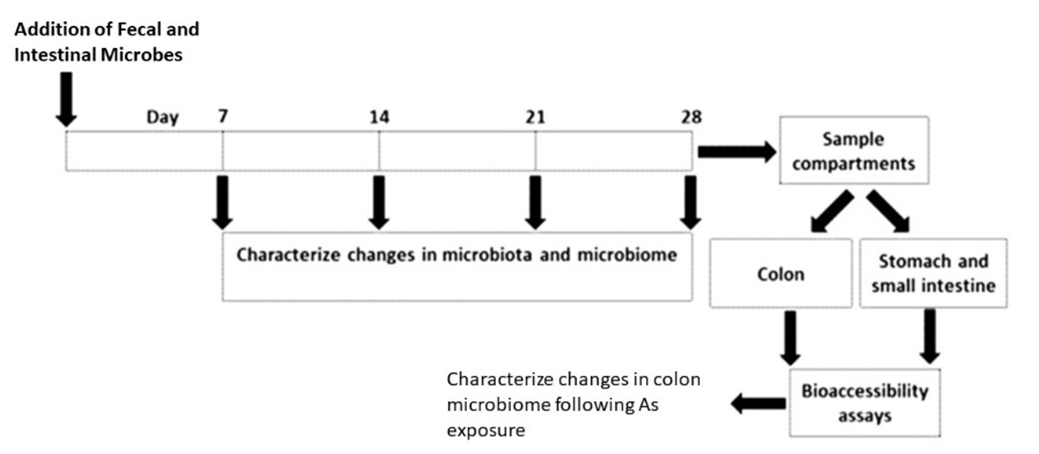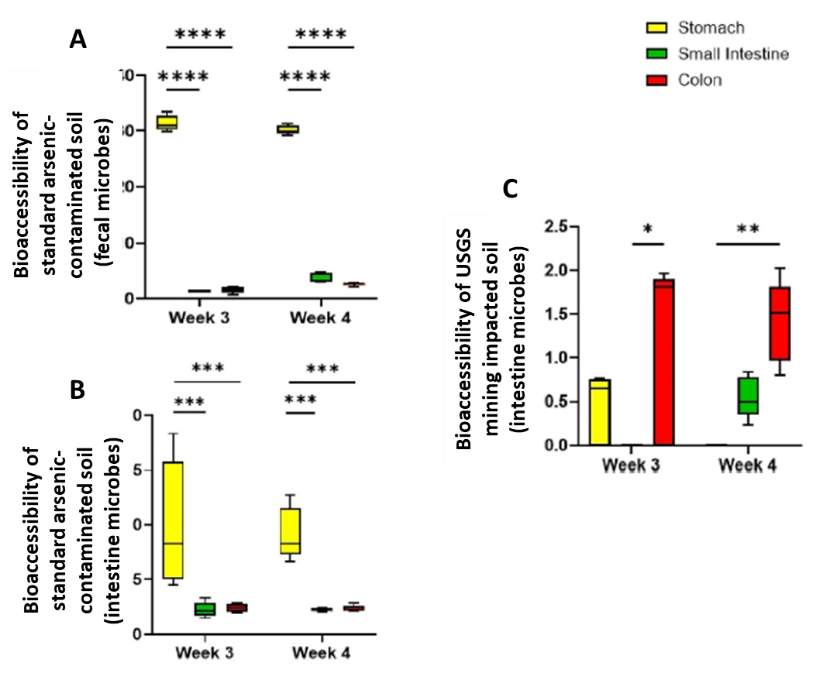Superfund Research Program
Disentangling Relationships Between Arsenic and the Gut Microbiome
View Research Brief as PDF(424KB)
Release Date: 10/06/2022
![]() subscribe/listen via iTunes, download(5.6MB), Transcript(84KB)
subscribe/listen via iTunes, download(5.6MB), Transcript(84KB)
Using an innovative method to simulate the gastrointestinal (GI) system, an NIEHS Superfund Research Program (SRP)-funded study revealed the interplay between arsenic exposure and the gut microbiome. The scientists assessed how arsenic alters the microbiome and how much arsenic can be dissolved into the bloodstream after being broken down by the gut, also known as bioaccessibility.
Arsenic can be found in food, soils, sediments, and groundwater. While food and water are the most common routes of exposure, children can ingest arsenic-contaminated soils through frequent hand-to mouth activity. Researchers know that arsenic exposure can disrupt the microorganisms living in the gut and that gut microbes can affect arsenic bioaccessibility and potential toxicity, but little is known about the complex relationship between arsenic exposure, the gut microbiome, and arsenic bioaccessibility.
The team included University of North Carolina at Chapel Hill (UNC) SRP Center Director Rebecca Fry, Ph.D., project leader Kun Lu, Ph.D., and colleagues Karen Bradham, Ph.D. and David Thomas, Ph.D., at the U.S. Environmental Protection Agency.
Exploring Arsenic in a Realistic Model of the GI System
The simulated GI system, developed by former UNC SRP Center trainee Jennifer Griggs, Ph.D., includes compartments that represent the stomach, small intestine, and colon. The team added microorganisms from mouse feces or the intestines to create a realistic microbiome. Then they exposed the system to arsenic contaminated soils from four different sites compared to a laboratory standard.

The team tracked changes in microbial DNA expression and in species richness and diversity to explore how arsenic exposure affected the gut microbiome. Because their approach can’t mimic the absorption of arsenic into the blood, they assessed how the different GI compartments broke down arsenic into a dissolved form as a surrogate for the amount that is bioaccessible. Finally, they compared their bioaccessibility data to a validated EPA test.
Relationship between Arsenic and the Gut Microbiome
While arsenic exposure did not affect fecal bacteria, it did reduce and eliminate multiple genera of intestinal bacteria, particularly members of Clostridiaceae, Rikenellaceae, and Parabacteroides, bacteria known to be critically involved in metabolic regulation. The researchers explained that intestinal bacteria, which appear to be more sensitive to arsenic, are more diverse and better represent the GI microbiome, highlighting the potential for far-reaching effects on human health.
They also found differences in how much arsenic was dissolved in each GI compartment by soil type. Specifically, arsenic bioaccessibility was highest in the stomach exposed to the standard arsenic contaminated soil. The authors note that the highly acidic environment may contribute to the increased bioaccessibility, but that site-specific soil properties are also important, as lower than expected amounts of arsenic dissolved in the stomach compartment for the other arsenic contaminated soils.

Interestingly, the team did not identify any effects on arsenic bioaccessibility that could be attributed to changes in microbial diversity and composition, except in the colon. In that compartment, the team found higher levels of bioaccessibility following exposure to an EPA reference material soil contaminated with arsenic, which they attributed to microbiome effects. According to the researchers, the microorganisms' effect on bioaccessibility may be dependent on the physical and chemical properties of the soil as well as the specific microbiome composition.
While the simulated GI system only matched the standard bioaccessibility assays results for the standard arsenic contaminated soil, these finding highlight the importance of different microbe species, soil properties, and arsenic geochemistry in arsenic exposure and bioaccessibility.
For More Information Contact:
Rebecca C Fry
University of North Carolina-Chapel Hill
Department of Environmental Sciences and Engineering
140 Rosenau Hall, CB #7431
Chapel Hill, North Carolina 27599
Phone: 919-843-6864
Email: rfry@email.unc.edu
Kun Lu
University of North Carolina-Chapel Hill
135 Dauer Drive
0031 Michael Hooker Research Center
Chapel Hill, North Carolina 27599
Phone: 919-966-7337
Email: kunlu@unc.edu
Karen D Bradham
U.S. Environmental Protection Agency, National Exposure Research Laboratory
To learn more about this research, please refer to the following sources:
- Griggs JL, Chi L, Hanley NM, Kohan M, Herbin-Davis K, Thomas DJ, Lu K, Fry RC, Bradham KD. 2022. Bioaccessibility of arsenic from contaminated soils and alteration of the gut microbiome in an in vitro gastrointestinal model. Environ Pollut 309:doi:10.1016/j.envpol.2022.119753 PMID:35835276
To receive monthly mailings of the Research Briefs, send your email address to srpinfo@niehs.nih.gov.


